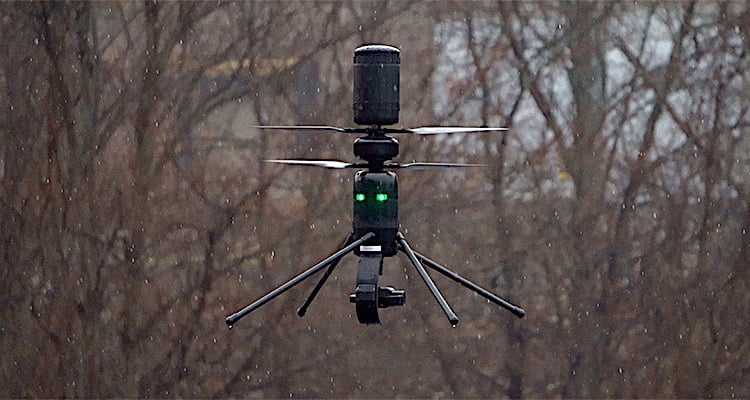Robinson Helicopter Company (RHC) has acquired drone maker Ascent Aerosystems, marking the OEM’s first major expansion under new CEO David Smith.
“These are the kinds of acquisitions that we think allow the best of Robinson to find the best in market technology and create a unique pairing,” Smith told Vertical.
While the terms of the deal were not disclosed, the company noted that “UAS [uncrewed aircraft systems] are increasingly integrated into traditional rotorcraft operations,” in announcing the acquisition.
Smith said this integration is particularly useful for law enforcement customers.
“Complex public safety needs more than what an individual tool is going to bring them — you need to provide them with a toolbox in a cleverly integrated package,” he said.
Smith also cited the Pentagon’s new Replicator initiative to rapidly acquire potentially thousands of autonomous vehicles within the next 18 to 24 months as another impetus for the deal.
“The Replicator initiative has set the stage for the need for mass scale platforms that can adapt in theater to changing threat environments,” he said. “The product is built to be modular, capable of shorter or longer range missions, with multiple payloads on the top and bottom [of the vehicle].”
Smith envisions a scenario where one or two Robinson helicopters would be teamed with 12 to 20 Ascent UAS vehicles, but he added that the simplicity of the integration would be critical to this pairing’s success. “There’s a need to get the information being produced by the UAS’s sensors quickly into the [helicopter] cockpit in a way that doesn’t increase workload for the crews.”
Founded in 2015 and based in Wilmington, Massachusetts, Ascent offers coaxial helicopter drones designed for industrial, public safety, and defense applications. Current models can either be air or ground launched from stationary or moving vehicles.
Designed to handle operations in high winds and other adverse weather conditions, the aircraft can be utilized for a variety of missions including search-and-rescue, rural firefighting, ISR (intelligence, surveillance, reconnaissance), precision delivery, and communications relay. Ascent has fielded approximately 600 units and offers two models: the Spirit and the larger NX30.
The Spirit features a cylindrical fuselage and has been designed to be compatible with the NATO standard launch tube and has been successfully air-launched. The vehicle is made of polycarbonates, composites, and aluminum; has a maximum takeoff weight of 13.5 pounds (six kilograms); a demonstrated ceiling of 14,600 feet (4,450 meters) msl; a maximum speed above 60 mph (95 km/h); and can operate in winds above 40 mph (65 km/h).
“We get a kick doing demonstration flights in conditions people don’t want to be outside in, let alone flying a UAV,” Ascent CEO Peter Fuchs told Vertical.
Smith said the “superior architecture” of Ascent’s UAV gives it the ability to “handle gusting winds, steady winds and all the things that drive unreliable outcomes from current generation drones.”
With a dual battery back, maximum endurance is 58 minutes (38 minutes with single pack). The vehicle has a height of 12 inches (30 centimeters), a core diameter of 4.2 inches (10 cm), and a tip-to-tip span of 25.5 inches (65 cm).
The larger NX30 features the same core diameter, but has a height of 32 inches (80 cm) and a tip-to-tip span of 36 inches (90 cm). It has a maximum takeoff weight of 30 pounds (13.6 kg) and an endurance of more than 65 minutes with dual battery packs.
Fuchs said both models are “highly modular” and feature “quick connect” interfaces for packages including EO/IR camera modules for NextVision, ViewPro, and Sony cameras and Gremsy gimbals. Ascent also offers a “payload development kit” for airframe inface with a wide variety of payloads, from LiDAR to complete autonomy systems.
He said most customers are systems integrators who order the “barebones” airframe and then install highly-customized mission packages. Customers are evenly split between the civil, parapublic, and military sectors.
Fuchs said that design and development would remain at the company’s facility in Wilmington, but that production would shift to RHC’s plant in Torrance, California. “We’re looking forward to leveraging Robinson’s significant expertise and manufacturing capabilities,” he said.
RHC’s Smith said that the Ascent UAVs would be sold as commercial, off-the-shelf products and that producing them would require minimal modification of the company’s existing facilities. Initially, he anticipates the acquisition will create approximately two dozen new jobs in Torrance.
“We don’t expect to add complexity to the business,” said Smith. “We can build these aircraft in a commercial environment that’s been proven to produce high-quality, aerospace-grade components at an affordable price.”





